JS 语法之--对象类型(构造器,class,this),高阶对象(高阶类,Minix模式)
1、JS 对象类型
JavaScript 是一种基于原型(prototype)的面向对象语言,而不是基于类的面向对象语言
C++, Java 有类Class 和实例Instance 的概念,类是一类事物 的抽象,而实例则是类的实体。
JS是基于原型的语言,它只有原型对象的概念,原型对象就是一个模板,新的对象从这个模板构建从而获取最初的属性,任何对象在运行的时候可以动态的增加属性,而且,任何一个对象都可以作为另一个对象的原型,这样后者就可以共享前者的属性。
2、定义类
字面式声明方式

这种方法也称为 字面值创建对象。JS 1.2 开始支持
ES6之前--构造器
1、应以一个函数(构造器)对象,函数名首字母大写
2、使用this 的定义属性
3、使用new 和构造器创建一个新对象
测试:
1 // 定义类,构造器 2 function Point(x, y) { 3 this.x = x; 4 this.y = y; 5 this.show = () => {console.log(this, this.x, this.y)} 6 console.log('======================') 7 } 8 9 //继承 10 function Point3D(a, b, z) { 11 Point.call(this,a,b) 12 this.z = z; 13 console.log('print3d') 14 } 15 16 console.log(Point3D) 17 p2 = new Point3D(1,2,3) 18 console.log('******************') 19 console.log(p2) 20 console.log('******************') 21 p2.show()
结果:
1 Info: Start process (19:52:17) 2 [Function: Point3D] 3 ====================== 4 print3d 5 ****************** 6 Point3D { x: 1, y: 2, show: [Function], z: 3 } 7 ****************** 8 Point3D { x: 1, y: 2, show: [Function], z: 3 } 1 2 9 Info: End process (19:52:17)
new 构建一个新的通用对象,new操作符会将新对象的this 值传递给Point3D 构造器函数,函数为这个对象创建 z 属性
从上句话知道,new 后得到一个对象,使用这个对象的this 来调用构造器,那么如何执行‘基类’的构造方法
使用Point3D 对象的this来执行Point 的构造器,所以使用call 方法,传入子类的this
最终,构造完成后,将对象赋值给 p2
注意:如果不使用new 关键字,就是一个普通函数的函数调用,this不代表实例。
ES6 中的class
从ES 6开始,新提供了class 关键字,使得创建对象更加简单,清晰。
- 类定义使用了class 关键字,创建的本质上海市函数,是一个特殊的函数
- 一个类只能拥有一个名为constructor 的构造方法,如果没有显式的定义一个构造方法,则会添加一个默认的constructor 方法
- 继承使用extends 关键字
- 一个构造器可以使用super 关键字来调用一个父类的构造函数
- 类没有私有属性。
测试:
1 // 基类定义 2 class Point { 3 constructor(x, y) /*构造器 */{ 4 this.name = x 5 this.age = y 6 } 7 show() /* 方法 */ { 8 console.log(this.name, this.age) 9 } 10 } 11 12 13 let p1 = new Point('tom', 12) 14 p1.show() 15 console.log(p1) // 可以看到对象的属性 16 17 //继承 18 class Point3D extends Point { 19 constructor (a,b,c) { 20 console.log('---------------------------') 21 super(a, b) 22 this.password = c 23 } 24 } 25 26 let p2 = new Point3D('jack',18,'123456') 27 p2.show() 28 console.log(p2)
结果:
1 Info: Start process (20:11:33) 2 tom 12 3 Point { name: 'tom', age: 12 } 4 --------------------------- 5 jack 18 6 Point3D { name: 'jack', age: 18, password: '123456' } 7 Info: End process (20:11:33)
重写方法:
子类Point3D 的show方法,需要重写

子类中直接重写父类的方法即可
如果需要使用父类的方法,使用super.method() 的方式调用
使用箭头函数重写上面的方法
1 // 基类定义 2 class Point { 3 constructor(x, y) /*构造器 */{ 4 this.name = x 5 this.age = y 6 // this.show = function () {console.log(this.name, this.age)} 7 this.show = () => console.log(this.name, this.age) 8 } 9 10 } 11 12 13 let p1 = new Point('tom', 12) 14 console.log(p1.show()) 15 console.log(p1) // 可以看到对象的属性 16 17 //继承 18 class Point3D extends Point { 19 constructor (a,b,c) { 20 console.log('---------------------------') 21 super(a, b) 22 this.password = c 23 // this.show = function () {console.log(this, this.name, this.age, this.password)} 24 this.show = () => console.log(this, this.name, this.age, this.password) 25 } 26 } 27 28 let p2 = new Point3D('jack',18,'123456') 29 p2.show() 30 console.log(p2)
结果:从运行结果看,箭头函数也支持子类的覆盖
1 Info: Start process (20:24:52) 2 tom 12 3 undefined 4 Point { name: 'tom', age: 12, show: [Function] } 5 --------------------------- 6 Point3D { name: 'jack', age: 18, show: [Function], password: '123456' } 'jack' 18 '123456' 7 Point3D { name: 'jack', age: 18, show: [Function], password: '123456' } 8 Info: End process (20:24:53)
测试:shou方法的调用次序
1 // 基类定义 2 class Point { 3 constructor(x, y) /*构造器 */{ 4 this.name = x 5 this.age = y 6 // this.show = function () {console.log(this.name, this.age)} 7 // this.show = () => console.log(this.name, this.age,'===1') 8 } 9 show() {console.log(this.name, this.age,'===2')} 10 11 12 } 13 14 let p1 = new Point('tom', 12) 15 console.log(p1.show()) 16 console.log(p1) // 可以看到对象的属性 17 18 //继承 19 class Point3D extends Point { 20 constructor (a,b,c) { 21 console.log('---------------------------') 22 super(a, b) 23 this.password = c 24 // this.show = function () {console.log(this, this.name, this.age, this.password)} 25 // this.show = () => console.log(this, this.name, this.age, this.password,'===3') 26 } 27 // show(){console.log(this, this.name, this.age, this.password,'===4')} 28 29 } 30 31 let p2 = new Point3D('jack',18,'123456') 32 p2.show() 33 console.log(p2)
通过测试,p2.show() 先调用自己类的对象 show,再 到父类的对象的show,在自己所属类的show在到父类的show
静态属性:
静态属性目前还没有很好的支持
静态方法;
在方法名前加上 static ,就是静态方法
1 class Add{ 2 constructor(x, y) { 3 this.x = x; 4 this.y =y; 5 } 6 static point() { 7 console.log(this.x) 8 } 9 } 10 11 add = new Add(20,40) 12 console.log(Add) 13 Add.point() 14 //add.point() 实例不能直接访问惊天方法,java 和C++ 一样 15 add.constructor.point();// 对象通过 constructor 访问静态方法
结果:
[Function: Add]
undefined
undefined
静态方法中的this 是Add类, 不是Add的实例
注:静态的概念不同于python的静态
this 的坑
虽然JS 和C++ java 一样有this,但是JS 的变现是不同的
原因在于c++ java 是静态编译语言,this是编译期间绑定,而js 是动态,运行期绑定
测试
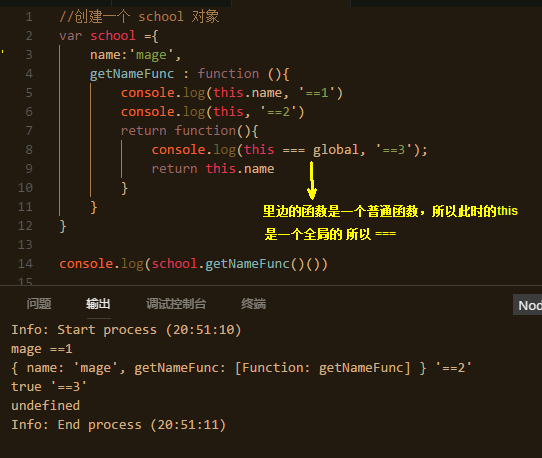
前提:
函数执行的时候,会开启新的执行上下文环境ExecutionContext
创建this 属性,但是this 是什么 就要看函数怎么调用。
- myFunction(1,2,3)普通函数调用方式,this 指向全局对象 ,全局对象是node.js的global或者浏览器中的window
- myObject.myFunction(1,2,3) 对象方法的调用方式,this指向包含该方法的对象
- call 和apply 方法调用,要看第一个参数是谁
分析上例:

解决方式 1:显式传入
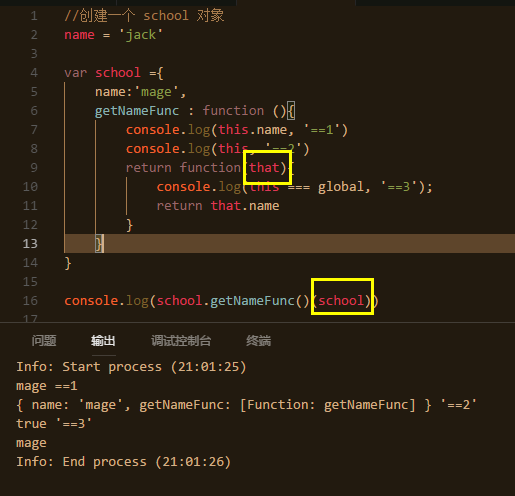
通过主动传入对象,这样就避开了 this 问题
解决方式2: ES3(ES-262第三版),引入了apply,call方法
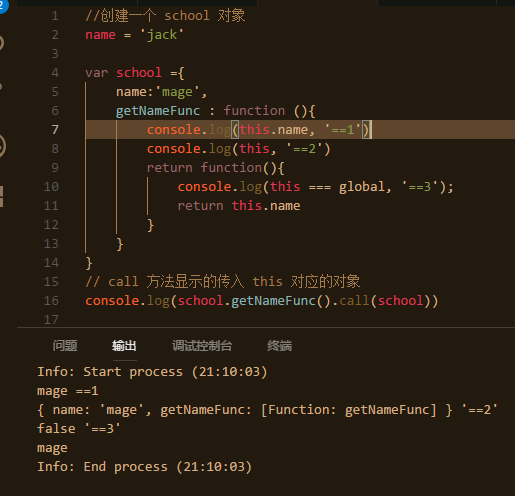
apply,call方法都是函数对象的方法,第一参数都是传入对象引入的

apply 传其他参数需要使用数组
call 传其他参数需要使用可变参数收集
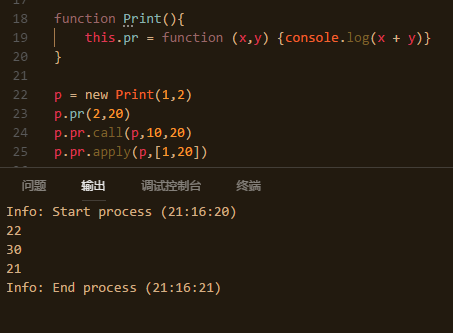
解决方式 3 ES5引入了bind方法
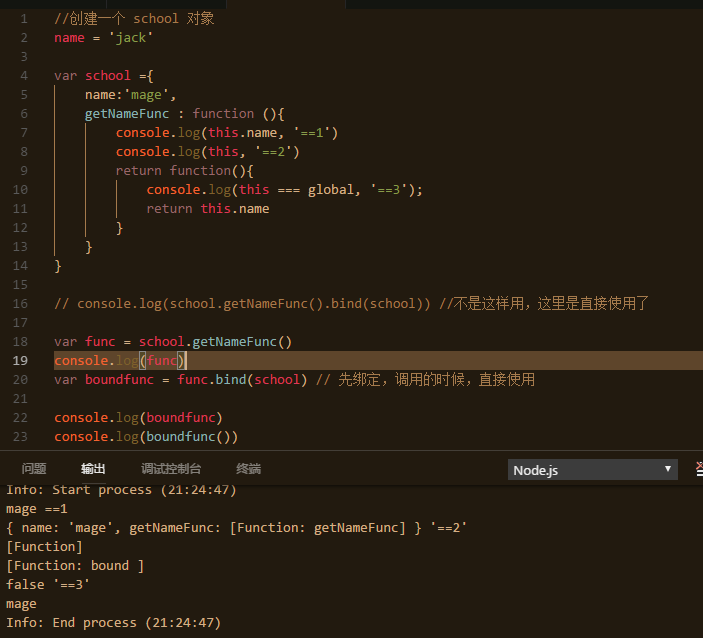
解决方式 4:ES6 支持this 箭头函数
ES6 新技术,就不需要兼容this 问题
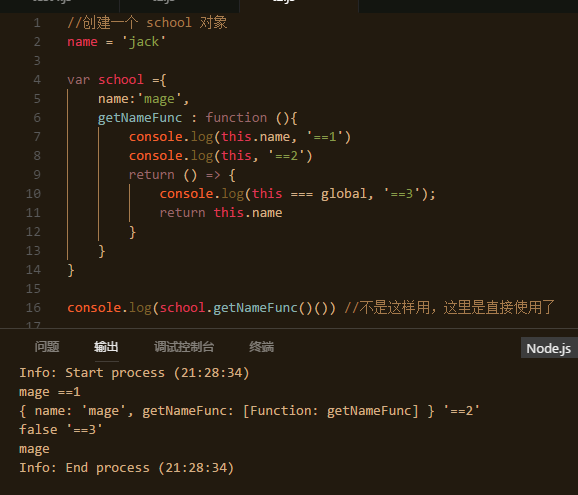
ES6 新的定义方式如下;
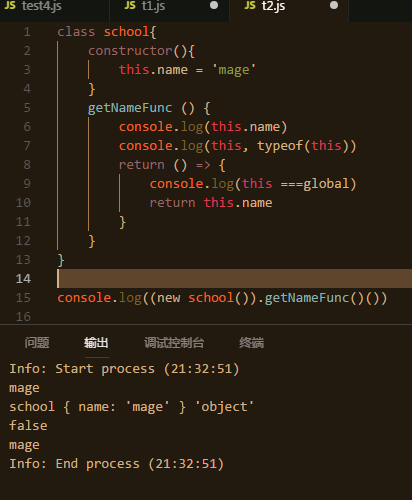
最常用的就是bind()
7、高阶对象,高阶类,或称为Mixin模式
Mixin模式。混合模式,这是一种不用继承 就可以 复用的技术,主要还是为了解决多重继承的问题,
多继承的继承路径是个问题
JS 是基于对象,类,和对象都是对象模板
混合Mixin 指的是,将一个对象的全部或者部分拷贝到另一个对象上去,其实就是属性了
可以将多个类或者对象混合成一个类或对象
继承的实现:
先看一个继承实现的例子:
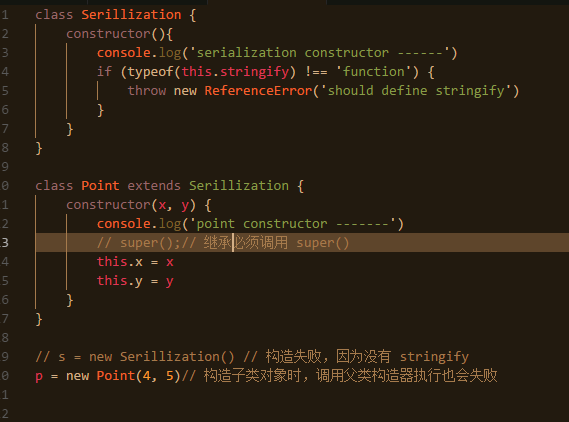
父类构造函数中,要求具有属性 stringify 的序列化函数,如果没有则抛出异常
1 class Serillization { 2 constructor(){ 3 console.log('serialization constructor ------') 4 if (typeof(this.stringify) !== 'function') { 5 throw new ReferenceError('should define stringify') 6 } 7 } 8 } 9 10 class Point extends Serillization { 11 constructor(x, y) { 12 console.log('point constructor -------') 13 super();// 继承必须调用 super() 14 this.x = x 15 this.y = y 16 } 17 stringify() { 18 return `<Point x=${this.x}, y=${this.y}>` 19 } 20 } 21 22 class Point3D extends Point{ 23 constructor(x, y, z){ 24 super(x, y) 25 this.z = z 26 } 27 stringify (){ 28 return `<Point x=${this.x}, y=${this.y}, z=${this.z}>` 29 } 30 } 31 32 p = new Point(4,5) 33 console.log(p.stringify()) 34 p3d = new Point3D(7,8,9) 35 console.log(p3d.stringify())
结果:
1 Info: Start process (21:53:17) 2 point constructor ------- 3 serialization constructor ------ 4 <Point x=4, y=5> 5 point constructor ------- 6 serialization constructor ------ 7 <Point x=7, y=8, z=9> 8 Info: End process (21:53:18)
高阶对象的实现:
将类的继承构建成箭头函数
1 // 普通的继承 2 class A extends Object{}; // 大写O 3 console.log(A) 4 5 // 匿名类 6 const A1 = class { 7 constructor(x) { 8 this.x = x 9 } 10 } 11 12 console.log(A1) 13 console.log(new A1(100).x) 14 15 console.log('--------------------------------------------') 16 17 // 匿名类继承 18 const B = class extends Object { // 这里返回的是一个类 19 constructor(){ 20 super() 21 console.log('B constructor') 22 } 23 } 24 console.log(B) 25 b = new B() 26 console.log(b) // B {} B 是? 27 28 29 console.log('--------------------------------------------') 30 const C = Sup => class extends Sup { // 这里返回的是一个函数 31 constructor(){ 32 super() 33 console.log('C constructor') 34 } 35 } 36 37 38 39 cls = new C(Object) // 不可以new 因为返回的是一个普通函数 40 41 42 obj2 = new (C(Object))() 43 44 cls = C(Object) // 返回来,调用一次,才能用// 返回一个类 45 obj = new cls() 46 console.log(obj) 47 48 // cls = C(A) 49 // console.log(cls) 50 // c = new cls() 51 // console.log(c) 52 53 // c1 = new (C(Object))()
改造上面序列化的例子:
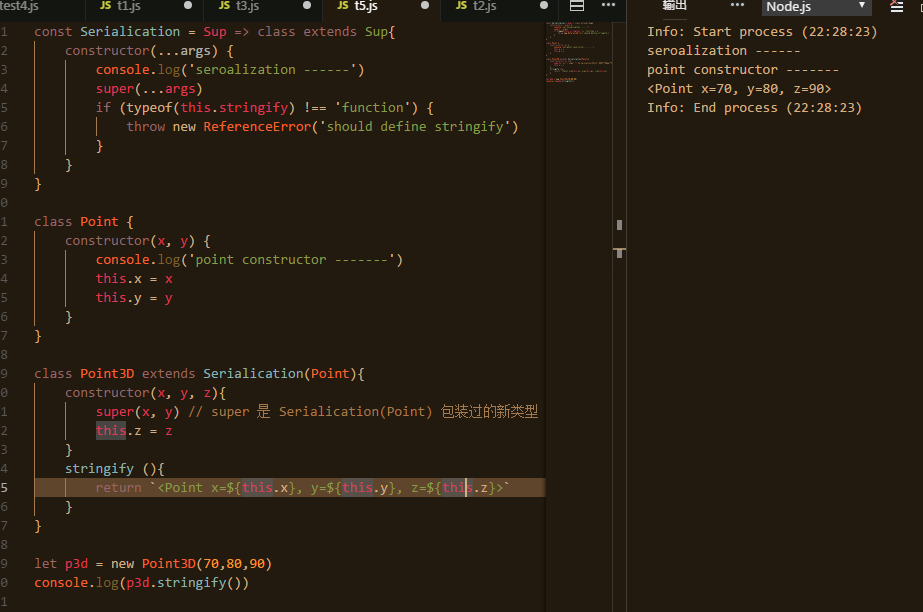

1 const Serialication = Sup => class extends Sup{ 2 constructor(...args) { 3 console.log('seroalization ------') 4 super(...args) 5 if (typeof(this.stringify) !== 'function') { 6 throw new ReferenceError('should define stringify') 7 } 8 } 9 } 10 11 class Point { 12 constructor(x, y) { 13 console.log('point constructor -------') 14 this.x = x 15 this.y = y 16 } 17 } 18 19 class Point3D extends Serialication(Point){ 20 constructor(x, y, z){ 21 super(x, y) // super 是 Serialication(Point) 包装过的新类型 22 this.z = z 23 } 24 stringify (){ 25 return `<Point x=${this.x}, y=${this.y}, z=${this.z}>` 26 } 27 } 28 29 let p3d = new Point3D(70,80,90) 30 console.log(p3d.stringify())




